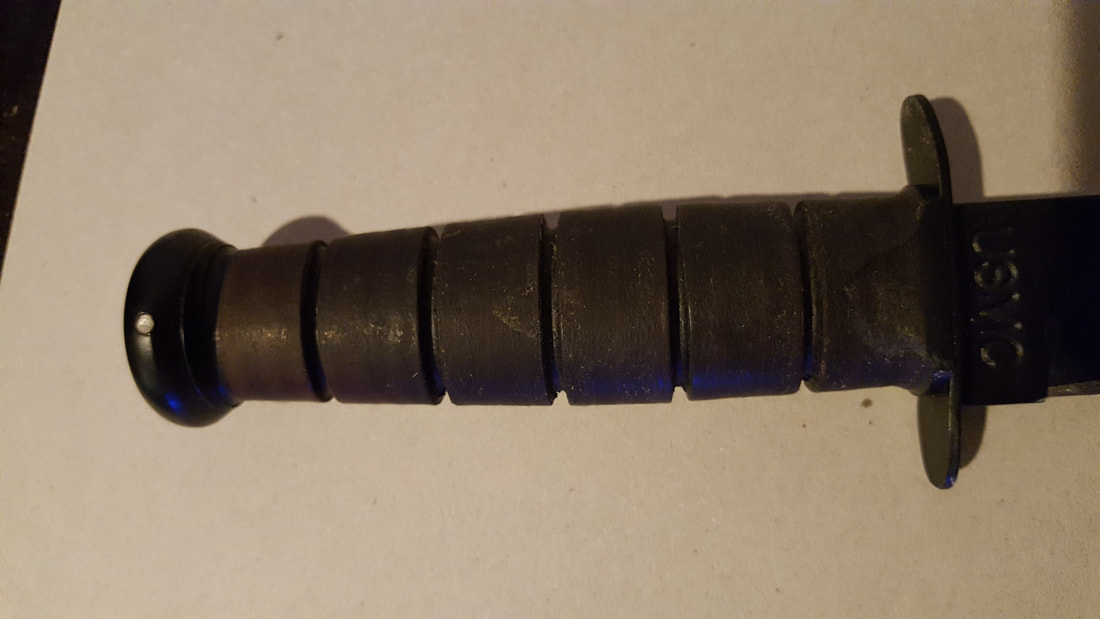|
When it comes to a good fighting knife, I typically look to Ka-Bar for a good standard. The decades of experience in war as a fighting/utility knife has given this knife a good amount of seniority, as well as a legendary status. Heck, this knife is basically like the 1911 of the knife world; most experienced fighting knife that is still a standard for combat fighting/utility knives. I have been a strong advocate for the tanto style blade for quite a while, but I still find the clip point of the Ka-Bar knife to be adequate and strong for penetration work. It may not be as strong as a tanto design, but I think you can thank the design of the blade for the strength that the clip point tip has. If I had to go to a clip point or other style of blade, I typically reference the Ka-Bar for how a blade design should be in order to help make sure it will stand the test of time. When it comes to utility knives and fighting knives, I would usually stick with a blade that is around 7 inches long. The reach is adequate for fighting, yet also a good minimum length and overall size for utility purposes such as hacking and slashing wood or other materials. If i were going to go for an outdoors knife, I would rather have a knife that has a length of at least 8 inches with a bit more weight and size. This would make wood chopping much easier overall. I have never been a fan of serrations on any type of blade. Ka-Bar makes nice rounded serrations, but they are still subject to the same issues as any other serrated blade. They can dull out and be a pain to sharpen again. I would much rather go without serrations, but I think Ka-Bar makes some of the best serrations if you must have them. The rounded profile can cut better, and will resist snagging for the most part. But, overall, if given a choice, I will take a straight edge over a serrated blade any day. The handle on the Ka-Bar is not the greatest handle in the world, but again I find that it is a good standard to go by. It is pretty well rounded and uses leather or kraton, which is pretty much like rubberized polymer. The handle is made up of little sections of materials called "washers" and there is a small space between each of these washers where the hand gets greater traction on the handle. The handle being well rounded makes for it being easy for the whole knife to spin in your hand while chopping. The guard of the handle also is a good baseline for what you should look for in a guard. The metal used for the guard is pretty minimal, if you ask me. It is slightly swooped back, which is not too comfortable when stabbing, but it does help stop the hand from moving forward and touching the blade. The metal of the guard seems to be pretty easy to bend, also. I have noticed that other knives that Ka-Bar makes, like the Fighter, have straight and thicker guards that are not as easy to bend. The butt of the handle is a good feature that I have found to be very useful, and it has been a very durable part. The standard Ka-Bar fighting knife is a good example of a guard that is functional but not top notch. The next thing I wanna talk about is the metallurgy of the steel. Now, I understand that people in general are not into finely researching metallurgy, but I feel that a basic understanding of metallurgy will help people understand what they might need. The standard Ka-Bar fighting/utility knife uses 1095 Cro-Van steel. This steel, as the name indicates, adds Chromium and Vanadium in order to give the 1095 better durability. 1095, according to the nomenclature, is made of 0.95% carbon, and that typically makes the blade more brittle. Adding Chromium and Vanadium to the metal makes the blade a bit more durable in comparison. These little details have helped me determine, when it comes to carbon steel, I either need a lower carbon steel for big utility knives or a combination of high-carbon steel and some extra minerals to help add to the durability. I think the Ka-Bar is a fine example of a blade that is well prepared and designed to handle rough tasks, down to the proper metallurgy. There is alot that goes into a good fighting knife, but at some point we need to set standards or minimums for knives that you are looking at. Of course the requirements for a folder and a fixed knife is going to be different. I just figured that I would share why the Ka-Bar is a standard, as far as fixed fighting/utility knives is concerned. The reason for this is because I have lots of experience with this knife and I have seen the successes and failures that you can see when using this knife for hard utility uses. It is not a "do it all" knife by any means, but it holds its own against others in it's size class. What are you think?
|
Do It RiteAlaska-Based Youtube Vlogger, Retired Marine, Firearm and Gear Tester. Archives
December 2023
Categories
All
|





 RSS Feed
RSS Feed